Tours → Incorta Tools
Incorta has all the built-in tools you need right now to start building, designing, securing, and operating your modern Direct Data Platform™. This tour will briefly introduce you to some of the features and functionality of various built-in tools.
You can use the links in the right side bar or simply scroll down.
Analyzer
Embracing the design themes of consistency, clarity, and efficiency, the Analyzer showcases modern analytics engineering with a user experience that promises increased productivity and delight.
What can I do with the Analyzer?
You can use the new Analyzer in a variety of ways:
- create and edit an insight on a dashboard tab
- create and edit an Incorta Analyzer Table in a physical schema
- create and edit an Incorta Analyzer View in a business schema
What does the Analyzer look like?
You can learn more about what the Analyzer looks like and how to use the Analyzer in the following interactive tour:
How do I access the Analyzer?
There are several ways to open the Analyzer with regards to creating or editing an insight for a dashboard tab:
- In the Action bar of dashboard, select +.
- For an insight in a dashboard tab, select More Options (⋮ vertical ellipsis icon) and then select Edit.
- In Content Manager, in the Action bar, select + New → Add Dashboard.
- In the Schema Designer for a given physical schema, in the Action bar, select Explore.
You can open the Analyzer to create and edit Incorta Analyzer Table. Here are the steps to create an Incorta Analyzer Table:
- In the Schema Designer for a given physical schema, in the Action bar, select + New → Derived Table → Incorta Analyzer.
- In the Data Source dialog, select the Pen icon.
You can open the Analyzer to create and edit an Incorta Analyzer View. Here are the steps to create an Incorta Analyzer View:
- In the Business Schema Designer for a given business schema, in the Action bar, select + New → Add New View.
- For the New View, in the View canvas, select Create in Analyzer.
Learn more
Learn more about the Analyzer and related concepts:
Business Schema Designer
The Business Schema Designer allows you to create, edit, and delete a runtime business view. There are two types of runtime business views for a business schema: a business schema view and an Incorta Analyzer View. The Business Schema Designer allows you to create and edit both types of views.
What can I do with the Business Schema Designer?
The Business Schema Designer supports two different modes: view mode and edit mode. Depending on the mode, you can perform different tasks.
View mode
The view mode is the default mode. Here are some of the tasks you can perform in view mode:
- search the business schema for a folder, view, or column
- explore the business schema in the Analyzer if a runtime business view already exists
- create a new folder or runtime business view
- view the columns in on or more runtime business views
- select a folder or view to edit
Edit mode
Here are some of the tasks you can perform in edit mode:
- create a new folder, business schema view, or Incorta Analyzer View
- edit a folder, business schema view, or Incorta Analyzer View
- delete a folder, business schema view, or Incorta Analyzer View
What does the Business Schema Designer look like?
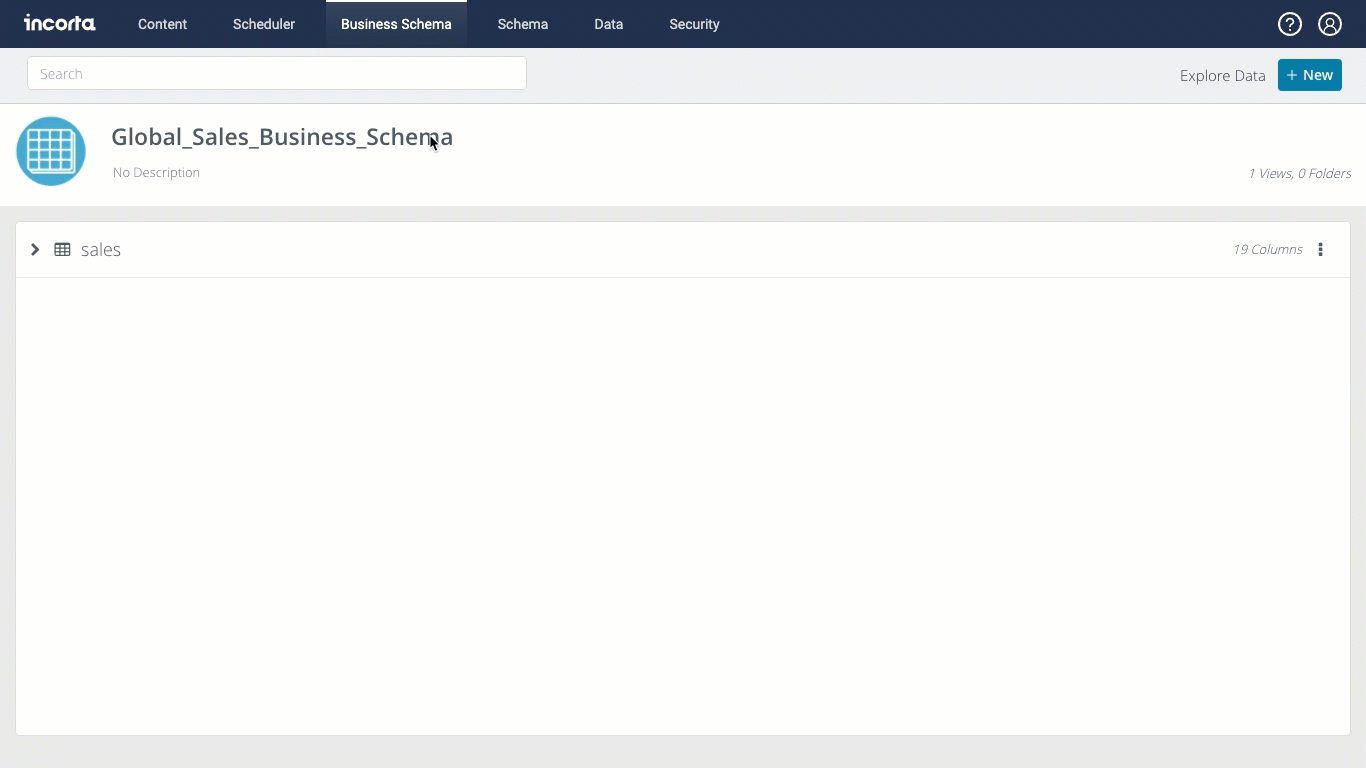
How do I access the Business Schema Designer?
To access the Business Schema Designer for an existing business schema, you must first open the business schema from the Business Schema Manager:
- In the Navigation bar, select Business Schema.
- In the list view, select a business schema.
When you create a new business schema using the Business Schema Manager, the Business Schema Designer automatically opens in view mode.
Learn more
Learn more about the Business Schema Designer and related concepts:
Business Schema Manager
The Business Schema Manager allows you to search for, create, and manage one or more business schemas. A business schema represents a runtime, logical schema of one or more entity objects.
What can I do with the Business Schema Manager?
Here are some of the tasks you can do with the Business Schema Manager:
- view a list of business schemas
- create a new business schema
- import one or more business schemas
- search for a business schema
- delete or export one or more business schemas
- edit or share a business schema
When you create a new business schema using the Business Schema Manager, the Business Schema Designer automatically opens in view mode.
What does the Business Schema Manager look like?

How do I access the Business Schema Manager?
To access the Business Schema Manager, in the Navigation bar, select Business Schema.
Learn more
Learn more about the Business Schema Manager, related tools, and related concepts:
Content Manager
The Content Manager allows a tenant user with the necessary access permissions to manage dashboards and favorites, and organize dashboards into folders. All users can access the Content Manager. The Content Manager contains folders and dashboards that you own or that have been shared with you.
What can I do with the Content Manager?
Here are some of the tasks that you can easily accomplish with the Content Manager:
- create a new dashboard or folder
- search for a dashboard or folder
- open a dashboard or folder
- share access to a dashboard or a folder
- favorite a dashboard
- play a playlist of favorite dashboards
What does the Content Manager look like?
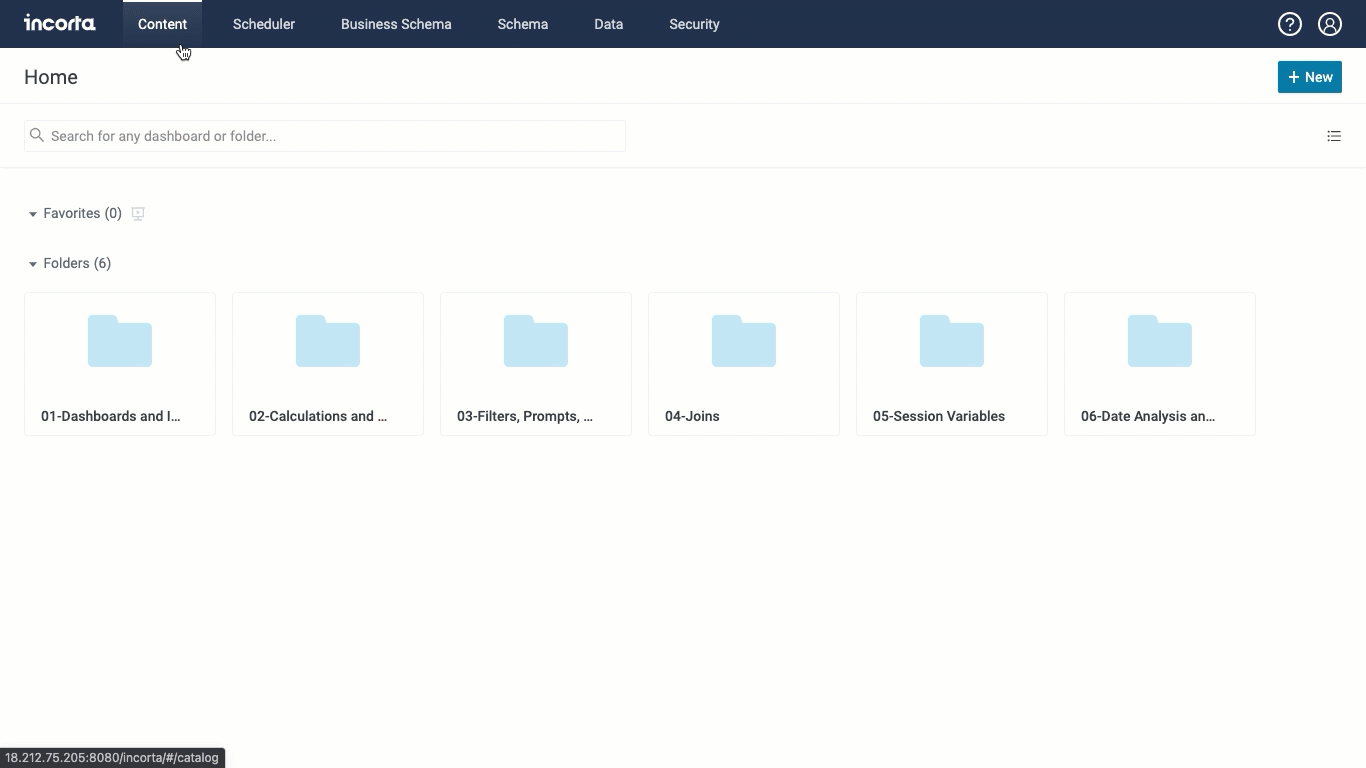
How do I access the Content Manager?
To access the Content Manager, in the Navigation bar, select Content.
Learn more
Learn more about using the Content Manager:
Data Manager
The Data Manager allows you to search for, create, and manage external data sources, local data folders, local data files, data agents, and data destinations.
An external data source defines how to make a connection to a an API, cloud storage, database, data lake, data warehouse, or SaaS service using a built-in connector.
A local data folder is a folder that you create or a folder that you upload to the Data Manager. A local data folder helps you organize local data files and other local data folders that are children to the parent local data folder.
A local data file is a file that you upload to Shared Storage.. The file is in one of the following file formats: .csv, .tsv, .tab, .txt, .xlsx, .gzip, or .zip.
The LocalFiles data source exposes the local data files and local data folders for a physical schema table that uses the File System connector as the data source. The File System connector supports selecting a local data file or a group of files from a local data folder.
A data agent allows you to ingest data from a database with a cloud or on-premises host system without using a VPN or SSH tunnel.
A data destination enables the seamless export of one or more supported insights to Google Drive or Google Sheets.
What can I do with the Data Manager?
Here are some of the tasks that you can accomplish with the Data Manager:
- create a new external data source, data destination, folder, or data agent
- search for a external data source, local data file, local data folder, data agent, or data destination
- delete an external data source, local data file, local data folder, data agent, or data destination
- generate an authentication file for a data agent
- edit an external data source, data agent, or data destination
- test and share an external data source or data destination
What does the Data Manager look like?
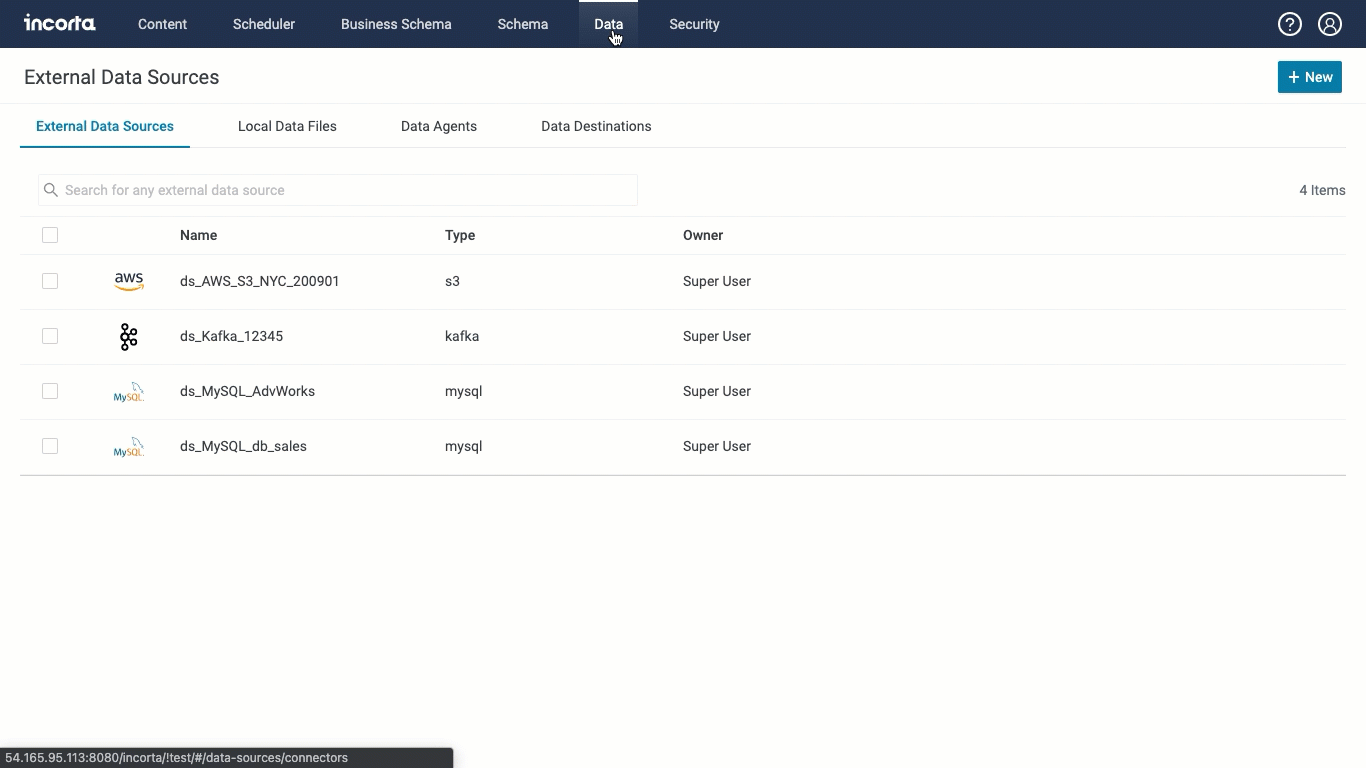
How do I access the Data Manager?
To access the Data Manager, in the Navigation bar, select Data.
Learn more
Learn more about the Data Manager and related concepts:
- Data Manager
- Connectors
- External Data Source
- Local Data File
- Local Data Folder
- Data Agent
- Data Destination
Formula Builder
The Formula Builder is tool that allows you to easily write and validate formula expression, filter expression, or an internal session variable query expression.
You use the Formula Builder to specify a query expression for an internal session variable, a filter expression, or for a formula expression for a column. Depending on the context of the expression and the expression type, you can create complex expression with the Formula Builder using built-in functions, system variables, and session variables.
What can I do with the Formula Builder?
Here are some examples of what you can do with the Formula Builder:
- create and edit a formula column in a physical schema table, Incorta Analyzer Table, materialized view, business schema view, Incorta Analyzer View, or insight
- create and edit a query expression for an internal session variable
- create and edit a filter expression for a filter expression session variable
- create and edit a filter expression for a filter option that uses a formula
- create and edit a filter expression for an applied filter that uses a formula
- create and edit a filter expression for an insight filter (except a Distinct filter)
- create and edit a filter expression for a runtime security filter that uses a formula
- create and edit a filter expression for a load filter
What does the Formula Builder look like?
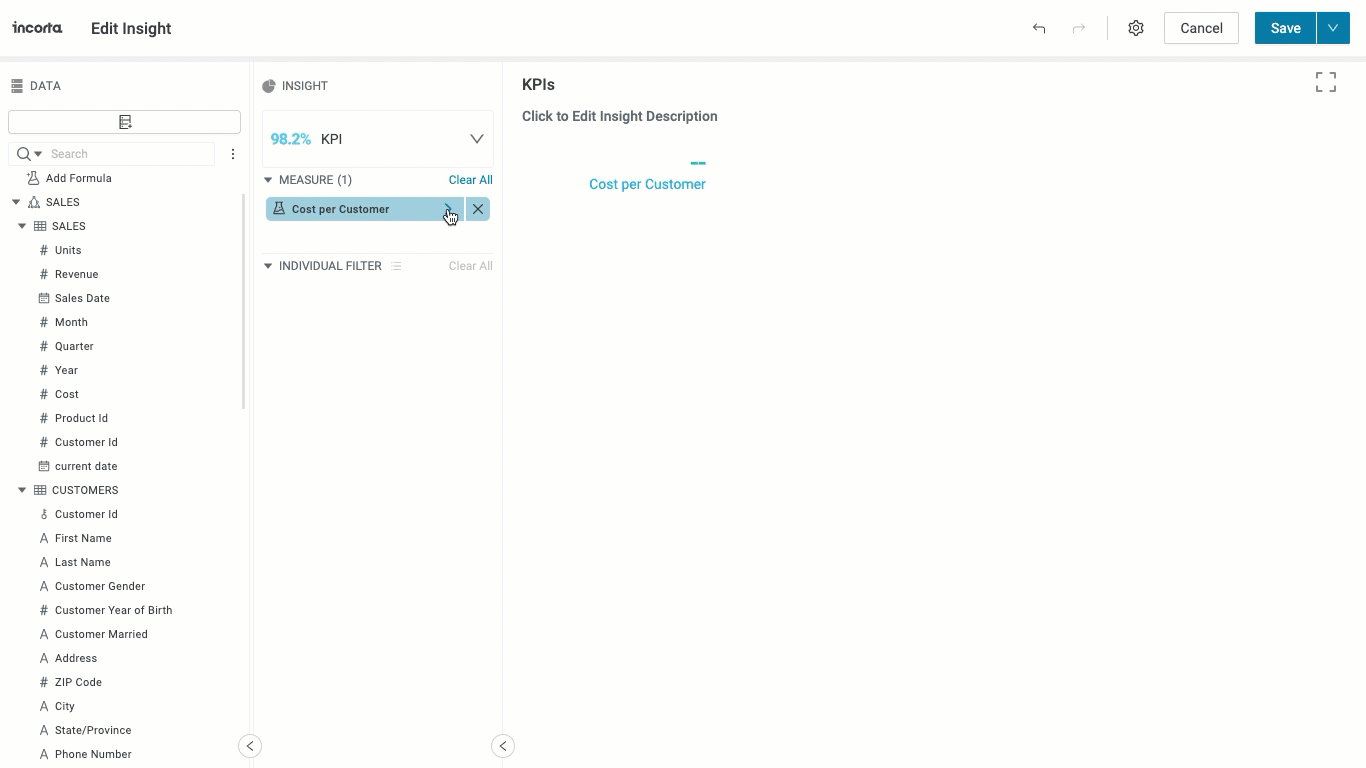
How do I access the Formula Builder?
You can invoke the Formula Builder in a variety of ways when you specify an expression:
- for a formula column in the Analyzer for an Incorta SQL Table, Incorta Analyzer View, or insight
- for a formula column, runtime security filter, or load filter in the Table Editor
- for internal session variable query expression
Learn more
Learn more about the Formula Builder and related concepts:
- Formula Builder
- Applied filter
- Filter expression session variable
- Filter option
- Formula column
- Insight filter
- Internal session variable
- Runtime security filter
- Load filter
Join Editor
The Join Editor allows you to create and manage Left-Outer Join relationships between two physical schema entity objects: a Child object and a Parent object. The types of entity objects in a physical schema are an alias, Incorta Analyzer table, Incorta SQL table, physical schema table, and materialized views. Between two entity objects, the Join Editor allows you to create or edit on or more join conditions and one or more join filters.
What can I do with the Join Editor?
Here are some the tasks you can perform with the Join Editor:
- create or edit a join condition
- delete all but the first join condition
- specify the join condition in terms of the the join condition columns and the join operator
- create, edit, or remove a join filter for a join filter column
What does the Join Editor look like?

How do I access the Join Editor?
There are several ways to access the Join Editor from various tools: Schema Designer, Schema Diagram Viewer, and the Table Editor.
Access the Join Editor using the Schema Designer
There are four different ways to access the Join Editor for a physical schema open in the Schema Designer:
- In the Action bar, select + New → Join.
- If there are no existing joins for the physical schema, in the Joins section, select Create New Join.
- In the Joins section, select a join.
- For a given join in the Joins section, in the Action menu (v arrow), select Join Details.
Access the Join Editor using the Schema Diagram Viewer
Here are ways to open the Join Editor using a physical schema open in the Schema Diagram Viewer:
- Select an arrow that represents a join relationship in the entity relationship diagram. In the Join drawer, select the square with arrow icon at the top of the drawer or beside a join condition.
- Select an object in the entity relationship diagram that is the Child in a join relationship (the base of a join relationship arrow). In the object details drawer, in the Child Joins section, select the square with arrow icon beside a join condition.
- Select an object in the in the entity relationship diagram that is the Parent in a join relationship (the target of a join relationship arrow). In the object details drawer, in the Parent Joins section, select the square with arrow icon beside a join condition.
Access the Join Editor using the Table Editor
Here are the options that you have to access the Join Editor using the Table Editor for a given physical schema object:
- If there are no existing Parent joins for the given physical schema object, in the Parent Joins, select + Add Parent Join.
- If there are no existing Child joins for the given physical schema object, in the Child Joins section, select + Add Child Join.
- In the Table Editor Action bar, select + New → Join (as parent). The current object is selected for the Parent side; however you can select another entity object in the same physical schema or another physical schema.
- In the Table Editor Action bar, select + New → Join (as child). The current object is selected for the Child side; however you can select another entity object in the same physical schema only.
Learn more
Learn more about the Join Editor, related tools, and related concepts:
Load Job Viewer
The Load Job Viewer shows the details of both the current load job and previous load jobs for a selected physical schema. The load job can be for the whole physical schema or a specific entity object in the physical schema.
What can I do with the Load Job Viewer?
Here are some of the tasks you can do in the Load Job Viewer:
- review the load job history
- select a load job to view its specific details
- navigate from the load job viewer back to the parent physical schema
- select a specific entity object and open it in the Table Editor
- filter the jobs summary list by Load Status
- view the error details for a non-successful load job
- filter the Job Details list by object name
- sort the Job Details list by object name
What does the Load Job Viewer look like?

How do I access the Load Job Viewer?
There are three ways to access the Load Job Viewer:
- In the Schema Manager, in the List View, for a physical schema with a Load Status other than No Data Loaded, select the Load Status link, for example select Success or Finished with Errors.
- In the Schema Manager, in the List View, for a physical schema with a Load Status other than No Data Loaded, select the Last Load link.
- In the Schema Designer for a given physical schema, in the Summary section, in Last Load Status, select the link:
- Please Load Data
- Date Time
- Load Status such as In Queue, Interrupted, or Finished with Errors
Learn more
Learn more about the Load Job Viewer, related tools, and related concepts:
Notebook Editor
The Notebook Editor is an interactive Apache Zeppelin notebook environment that allows you to explore, manipulate, and transform data for a materialized view in a physical schema. The Notebook Editor supports several languages including PySpark, R, Scala, Spark SQL, and PostgreSQL. You can use the Notebook Editor to iteratively code and explore your data before saving code for the materialized view.
What can I do with the Notebook Editor?
Here are just a few things that you can do with the Notebook Editor:
- add one or more paragraphs using a language declaration
- specify the paragraph code
- run the code for all paragraphs or a specific paragraph
- view the results for a specific paragraph as a table, bar chart, pie chart, area chart, line chart, or scatter chart
- view the results using a notebook visualization
What does the Notebook Editor look like?

How do I access the Notebook Editor?
When creating a new materialized view in a physical schema, you can edit the Script property using the Notebook Editor. Here are the steps:
- In the Navigation bar, select Schema.
- In the Schema Manager, in the list view of schemas, select an existing physical schema.
- In the Action bar of the Schema Designer, select + New → Derived Table → Materialized View.
- In the Data Source dialog, in Script, select Edit in Notebook.
To edit an existing materialized view using the Notebook Editor, follow these steps:
- In the Navigation bar, select Schema.
- In the Schema Manager, in the list view of schemas, select an existing physical schema.
- In the Schema Designer, select a materialized view.
- In the Table Editor, select in the Table Summary section, select the materialized view data source.
- In the Data Source dialog, in Script, select Edit in Notebook.
Learn more
Learn more about the Notebook Editor, related tools, and related concepts:
Scheduler
The Scheduler allows you to both manage the scheduled jobs for dashboard delivery and create and manage scheduled jobs for physical schema loads, data notifications, and schema notifications.
Incorta sends the scheduled dashboards, data notifications (dashboard alerts), or schema notifications in an email to the recipients you enter while creating the scheduled jobs. You can also deliver a dashboard to a Data Destination.
What can I do with the Scheduler?
Here are some of the tasks that you can easily accomplish with the Scheduler:
- view and edit a schedule for dashboard delivery
- add, edit, and delete a schedule for a schema load
- create a data notification about an alert condition for a dashboard
- create a schema notification about the success or failure for one or more schema load operations
What does the Scheduler look like?
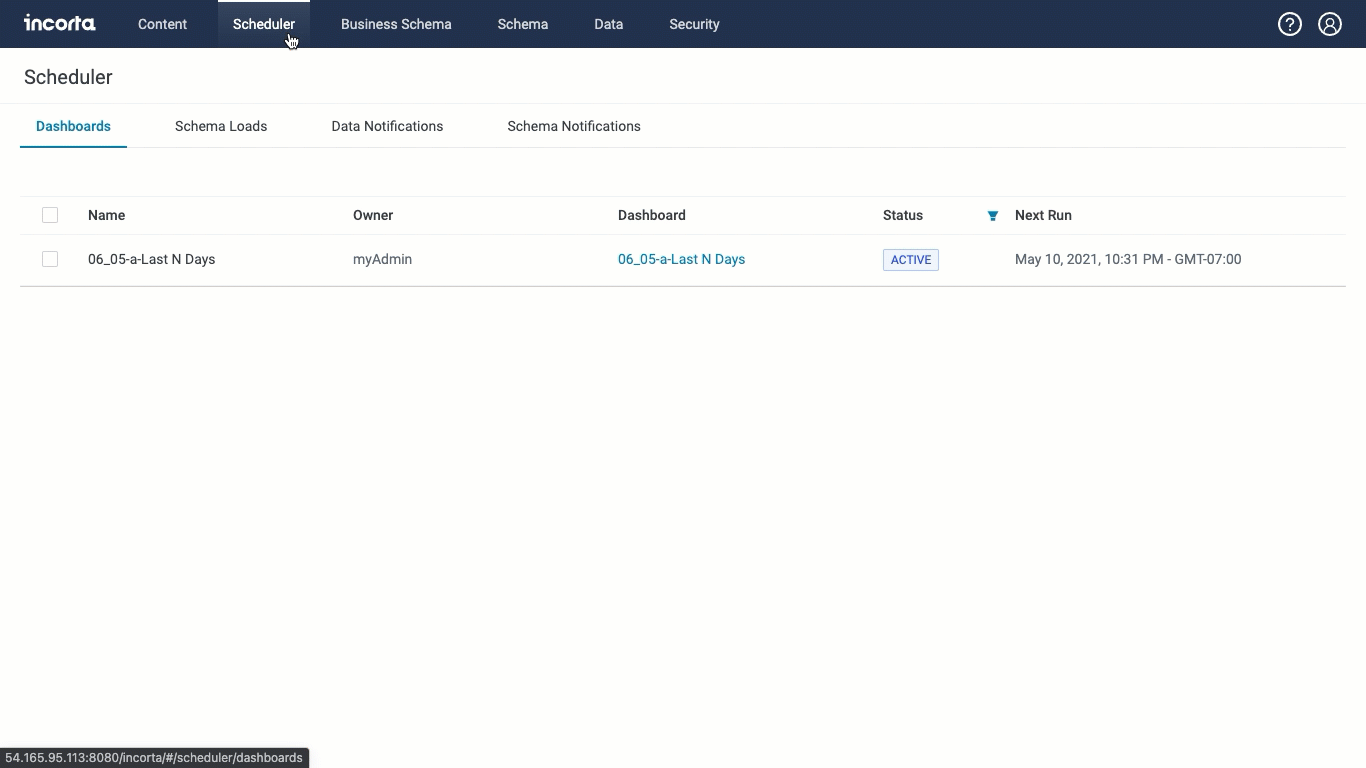
How do I access the Scheduler?
To access the Scheduler, in the Navigation bar, select Scheduler.
Learn more
Learn more about using the Scheduler:
Schema Designer
The Schema Designer allows you to manage entity objects and joins for a physical schema. You also use the Schema Designer to initiate or schedule a load job for an entire physical schema or a given entity object in the physical schema. An entity object in a physical schema is one of the following:
What can I do with the Schema Designer?
Here are some of the tasks that you can accomplish with the Schema Designer:
- search for an entity object or a column in an entity object in a physical schema and then open the entity object in the Table Editor
- initiate or schedule a load job for a physical schema
- explore a physical schema in the Analyzer
- view an entity relationship model for a physical schema in the Schema Diagram Viewer
- enable or disable performance optimization for various entity objects in a physical schema
- change the load order of various entity objects for a physical schema
- create an email notification about the success or failure for a physical schema load job
- view the version history of changes to a physical schemas
- share a physical schema with various users and groups
- create a new entity object using the Schema Wizard or the Table Editor
- create a new join between entity objects with the Join Editor
- view a summary of the las load job including the number of rows and the file size in shared storage
- open the load job history in the Load Job Viewer
- view a list of entity objects
- view a list of joins between objects
What does the Schema Designer look like?
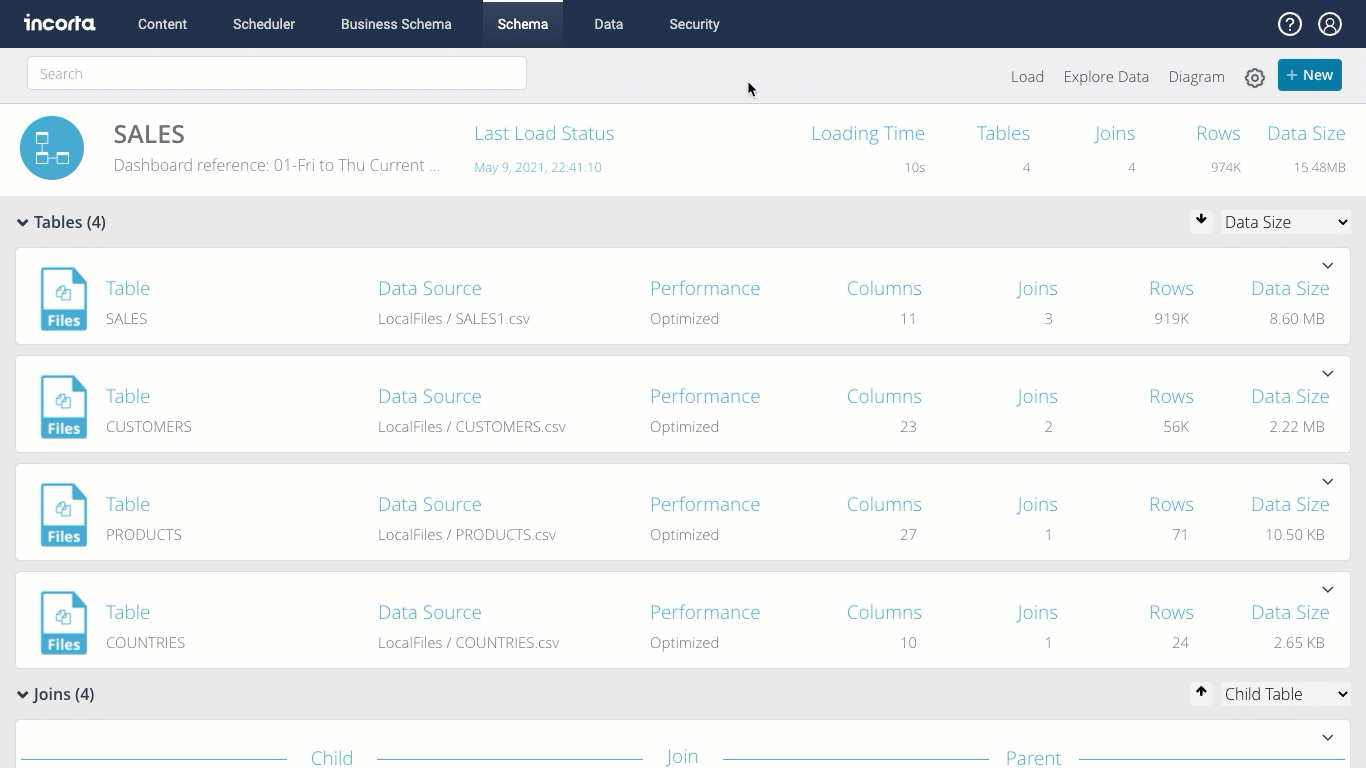
How do I access the Schema Designer?
To open the Schema Designer for a physical schema, follow these steps.
- In the Navigation bar, select Schema.
- In the Schema Manager, in the list view of schemas, select an existing physical schema.
Learn more
Learn more about using the Schema Designer, related tools, and related concepts:
Schema Diagram Viewer
The Schema Diagram Viewer allows you to view an entity relationship diagram for the selected physical schema and any related and viewable physical schemas. This includes all entity objects and join relationships between entity objects. An entity object in a physical schema is one of the following:
What can I do with the Schema Diagram Viewer?
Here a few of the tasks that you can do in the Schema Diagram Viewer:
- view the entity relationship diagram for the given physical schema including zooming in or out and selecting an area of focus
- change the layout of the entity relationship diagram
- search for a specific entity object by name
- view the details about a specific entity object and open the object in the Table Editor
- view the details about a specific join between entity objects and open the join in the Join Editor
What does the Schema Diagram Viewer look like?
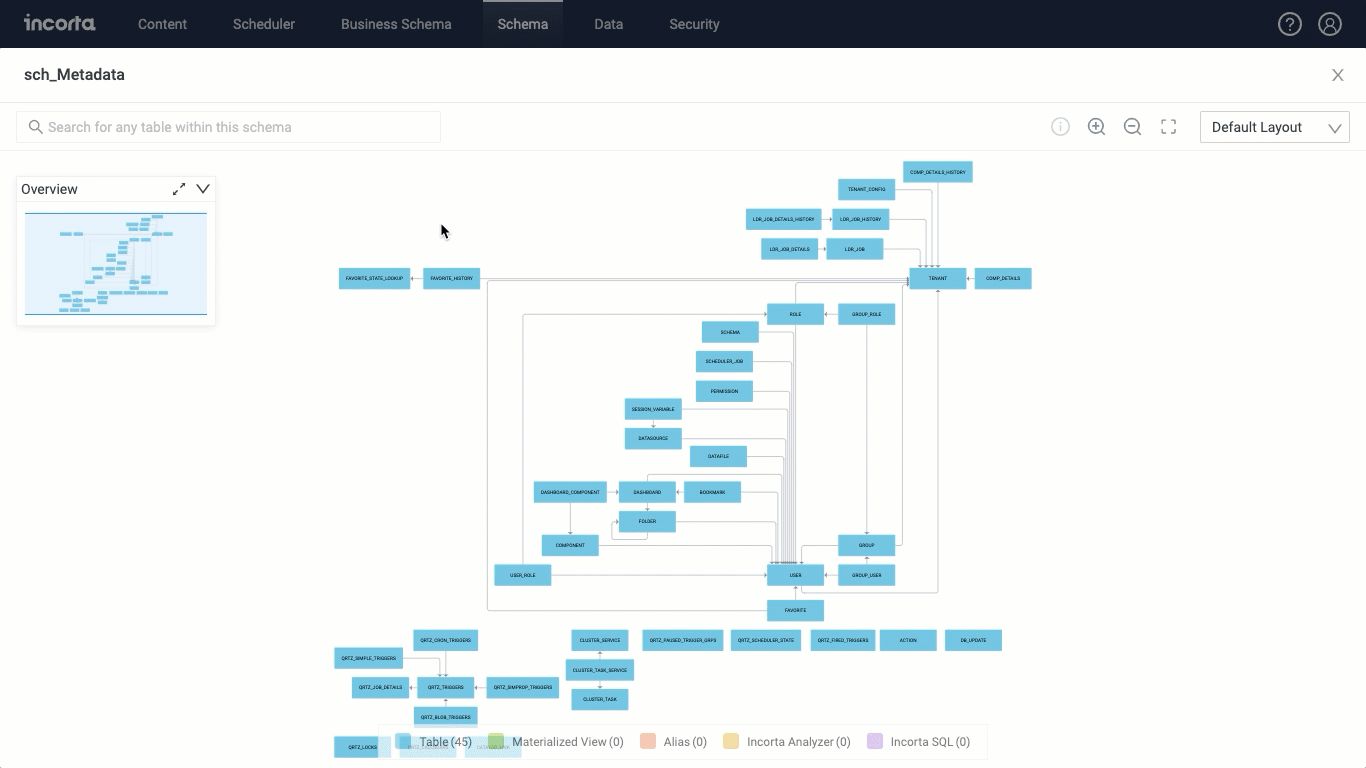
How do I access the Schema Diagram Viewer?
To open the Schema Diagram Viewer for a physical schema, follow these steps.
- In the Navigation bar, select Schema.
- In the Schema Manager, in the list view of schemas, select an existing physical schema.
- In the Action bar of the Schema Designer, select Diagram.
Learn more
Learn more about using the Schema Diagram Viewer and related concepts:
- Schema Diagram Viewer
- Physical schema
- Join
- Alias
- Incorta Analyzer Table
- Incorta SQL Table
- Materialized view
- Physical schema table
Schema Manager
The Schema Manager allows you to search for, create, and manage physical schemas, session variables, and global variables.
A physical schema defines one or more entity objects and the relationships between entity objects. It also defines how the Loader Service extracts, loads, and enriches data for the physical schema, and how the Analytics Service loads data into memory for the physical schema.
A session variable value is a user-defined variable. A variable stores data of a specific data type. A session variable is immutable within the variable scope of a user session. There are three types of session variables: external, internal, and filter expression.
A global variable has a name, description, type, and value. A global variable is a static variable and is available to all users in a tenant.
What can I do with the Schema Manager?
Here are some of the tasks that you can easily accomplish with the Schema Manager in relation to a physical schema:
- create a physical schema using the Schema Wizard
- open a physical schema in the Schema Designer
- schedule a physical schema load job
- view the most recent load job detail for a physical schema in the Load Job Viewer
- import and export a physical schema
- search for, delete, and share a physical schema
- enable or disable performance optimization for various entity objects in a physical schema
- change the load order of various entity objects for a physical schema
- create an email notification about the success or failure for a physical schema load job
- schedule a load job for a physical schema load job
Here are some of the tasks that you can easily accomplish with the Schema Manager in relation to a session variable:
- create and edit an external session variable, an internal session variable, or a filter expression session variable
- search for, delete, and share an external session variable, an internal session variable, or a filter expression session variable
- test an external session variable, an internal session variable, or a filter expression session variable as the current user or another user
Here are some of the tasks that you can easily accomplish with the Schema Manager in relation to a global variable:
- create and edit a global variable
- search for and delete a global variable
What does the Schema Manager look like?
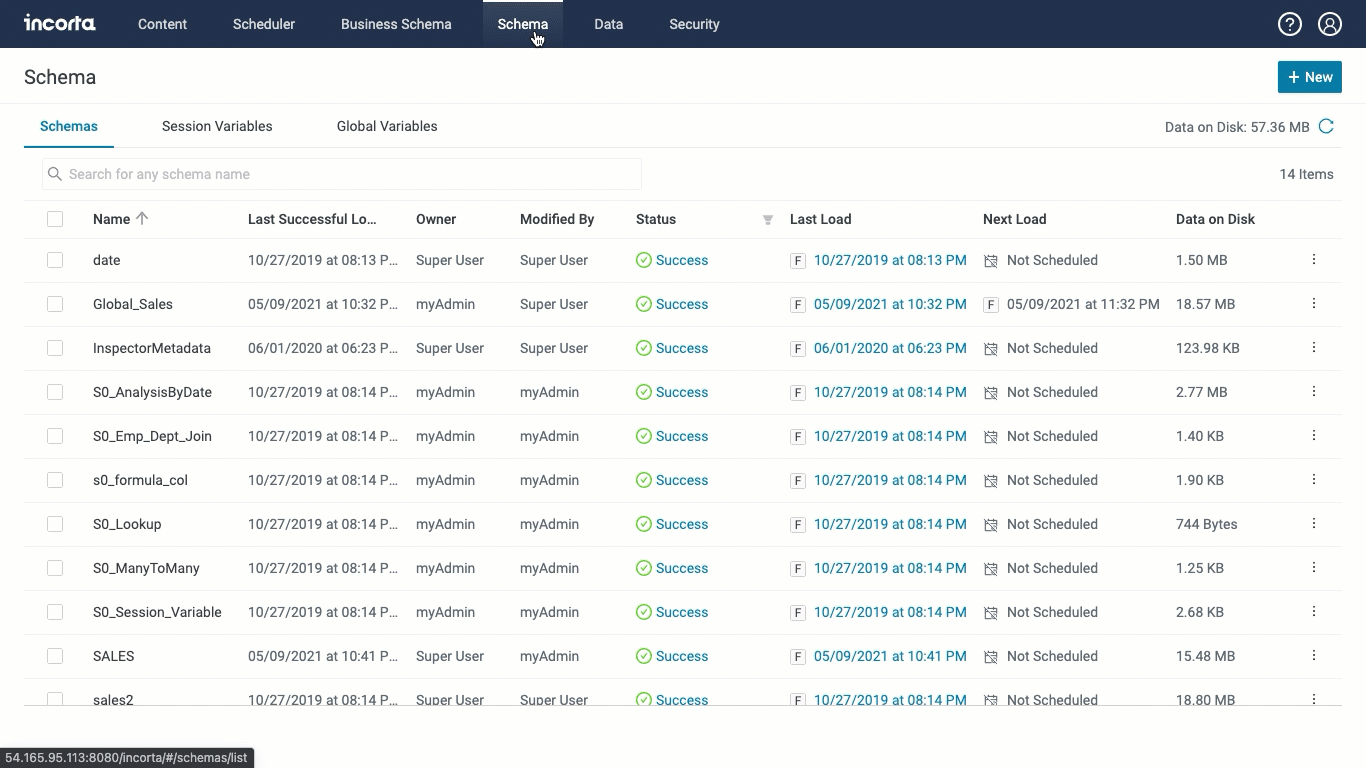
How do I access the Schema Manager?
To access the Schema Manager, in the Navigation bar, select Schema.
Learn more
Learn more about using the Schema Manager and related concepts:
- Schema Manager
- Physical schema
- External session variable
- Internal session variable
- Filter expression session variable
- Global variable
Schema Wizard
The Schema Wizard allows you to quickly and simply build a physical schema comprised of one or more physical schema tables. The Schema Wizard uses an existing data source to define one or more physical schema tables. Depending on the data source type, the Schema Wizard also detects foreign key to primary key table relationships in the data source, and in turn, defines these as child-to-parent join relationships between physical schema tables within the physical schema.
What can I do with the Schema Wizard?
Here are some of the things that you can do with the Schema Wizard when creating a physical schema:
- create a physical schema for an external data source
- select a table from an external data source to include as a physical schema table
- when applicable, customize the SQL for a selected data source table
- create a new physical table using a SELECT command (such as a existing database view)
- define the columns to include in a physical schema table
- for a column, define the Incorta Label, Incorta Type, and Incorta Function properties
- specify to include or exclude in the physical schema any existing data source foreign key to primary key table relationships
What does the Schema Wizard look like?
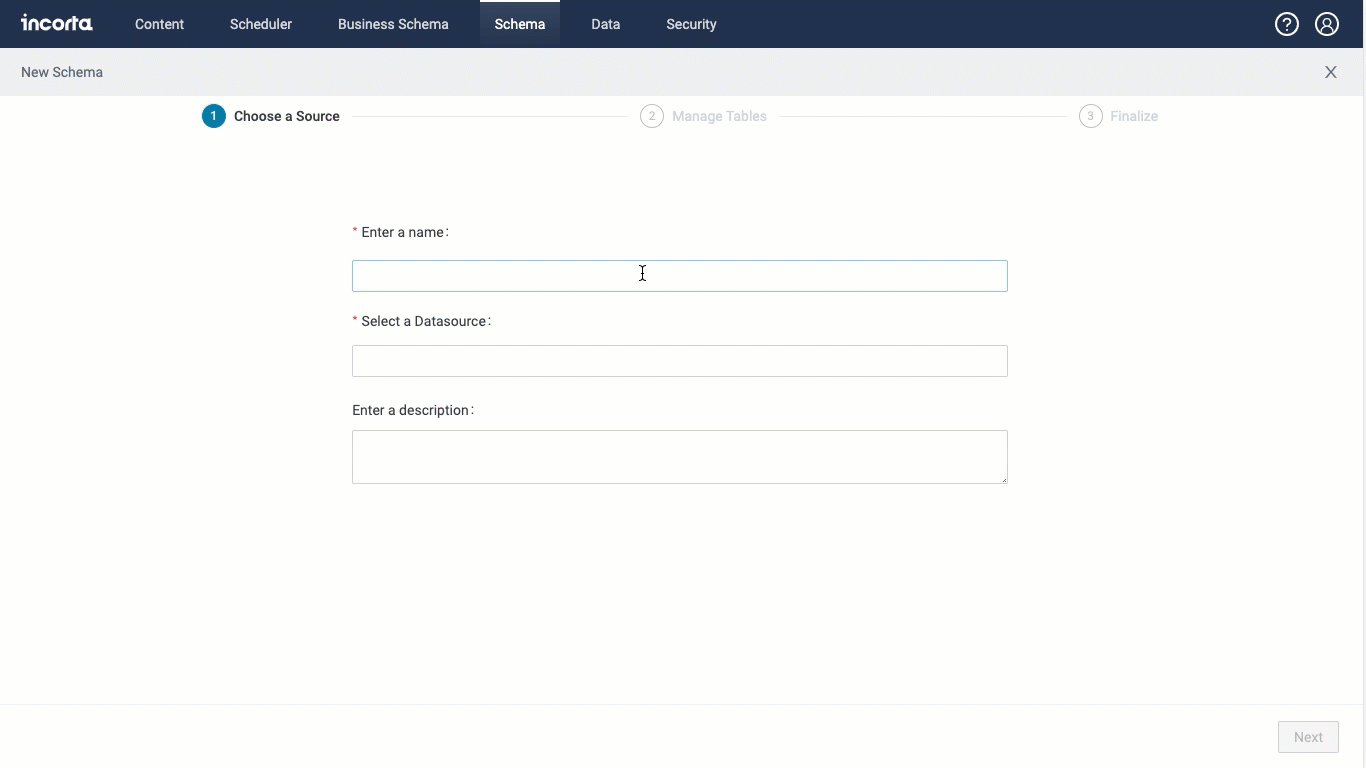
How do I access the Schema Wizard?
To open the Schema Wizard to create a physical schema, follow these steps:
- In the Navigation bar, select Schema.
- In the Action bar of the Schema Manager, select + New → Schema Wizard.
You can also use the Schema Wizard to create one or more physical schema tables with theses steps:
- In the Navigation bar, select Schema.
- In the Schema Manager, in the list view of schemas, select an existing physical schema.
- In the Action bar of the Schema Designer, select + New → Schema Wizard.
Learn more
Learn more about using the Schema Wizard and related concepts:
Security Manager
The Security Manager allows you to create and manage users and groups so as to both enable sharing and restrict access. Using built-in Security Roles, you are able to assign access permissions to groups of users. Known as a Role Based Access Control (RBAC), you can easily enforce access to certain features and functionality within Incorta.
What can I do with the Security Manager?
Here are a few of the actions that you can take with the Security Manager:
- create, edit, and delete a group or a user
- search for a user or a group
- assign or un-assign on or more security roles to a group
- add and remove on or more uses from a group
- create a mapping between users and groups for LDAP
- enable API Key generation for a user
- reset the password for a user
- for a deleted user, assign object ownership to another user
What does the Security Manager look like?
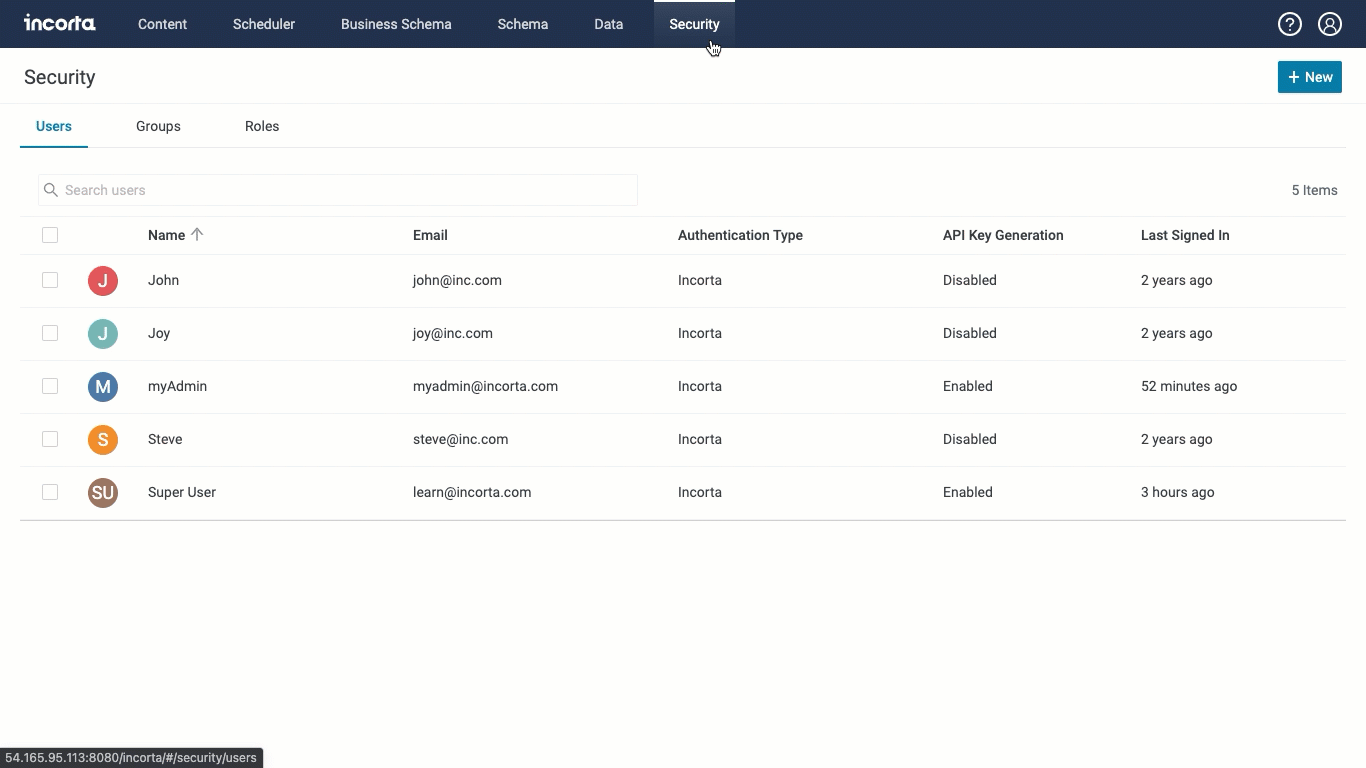
How do I access the Security Manager?
To access the Security Manager, in the Navigation bar, select Security.
Learn more
Learn more about using the Security Manager:
Table Editor
The Table Editor allows you to define the properties of physical schema entity objects such as an:
What can I do with the Table Editor?
Here are a few of the tasks that you can accomplish with the Table Editor:
in the Action bar, select + New, and in the Add New Menu, select one of the following menu options:
- Formula Column: select to create a new formula column
- Security Filter: select to add a new runtime security filter
- Join (as parent): select to add a new join relationship for the entity object as a parent
- Join (as child): select to add a new join relationship for the entity object as a child
in the Table Summary section, you can:
- Performance Optimized: toggle this option off to load the object data into Shared Storage only or toggle this option on to both load the object data into Shared Storage load data and into the memory of the Analytics Service
- Edit the existing Data Source: select the existing data source and edit various properties in the Data Source dialog
- Add a new Data Source: select + to open the the Data Source dialog and define various properties
in the Columns section, you can:
- Preview data: select Preview data to view a preview of the entity object's data
- search for column
- sort columns by property
- Modify columns: edit and modify various column properties including the Label, Type, Function, Source Encyrpted, and Encrypt
in the Formula Columns section, you can:
- create a new formula column or edit an existing formula column
- edit a formula column expression using the Formula Builder
in the Runtime Security Filters section, you can:
- Create a new runtime security filter or edit an runtime security filter
- edit runtime security filter using the Formula Builder
in the Parent Joins and Child Joins section, you can:
- view the Join details in the Join Editor
- remove the join
In the Load Filter section, you can:
- define a load filter expression using the Formula Builder
What does the Table Editor look like?
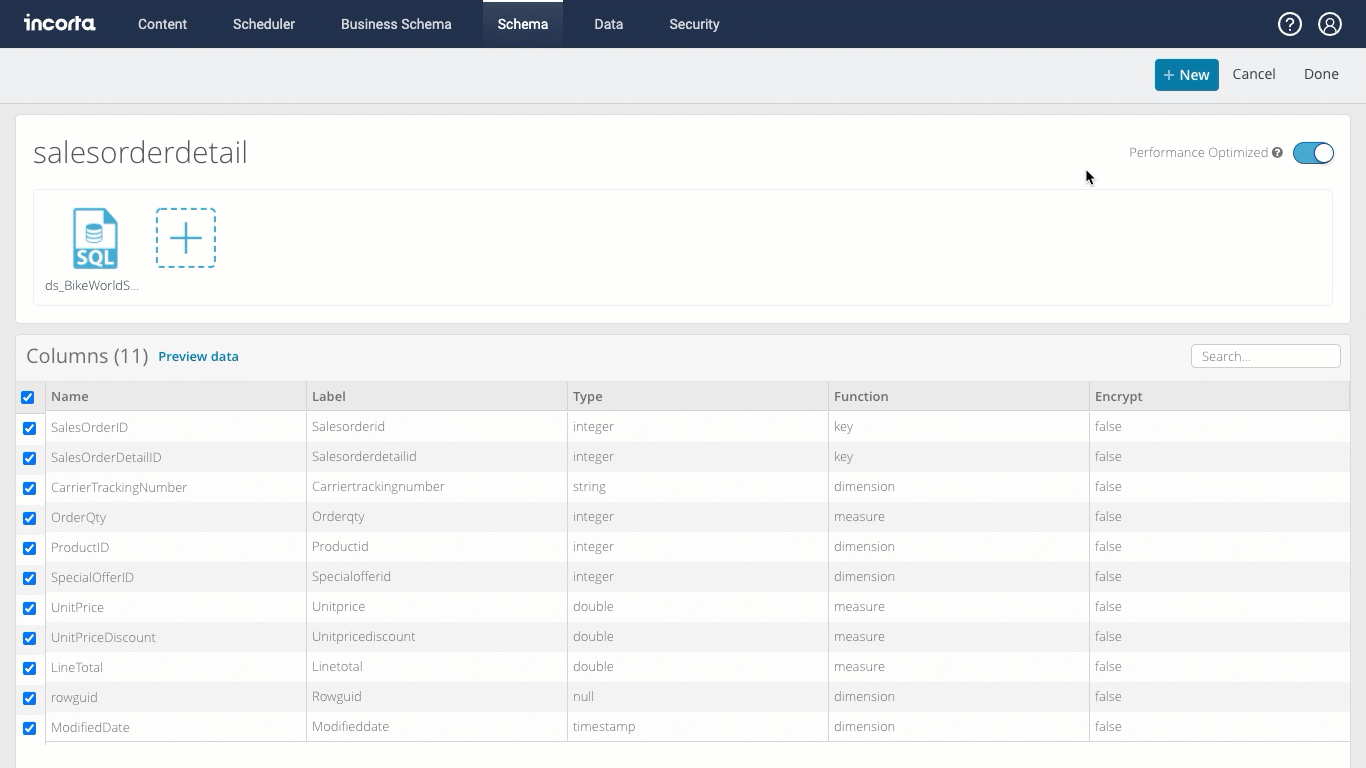
How do I access the Table Editor?
You can access the Table Editor for an entity object in a physical schema using the:
Access the Table Editor using the Schema Designer
There are multiple options or paths that you have to access the Table Editor for a given object using the Schema Designer for a physical schema that you own or have access rights to:
- If there are no existing entity objects in the physical schema in the Schema Designer, in the Start adding tables to your schema section, select the type of either the entity object or the data source for the new object, except for the Schema Wizard. Use the Data Source dialog to define the data source properties, and then select Add.
- In the Action bar, select + New → Table, and then select the type of the data source you want for the new physical schema table.
- In the Action bar, select + New → Alias.
- In the Action bar, select + New → Derived Table → Incorta Analyzer.
- In the Action bar, select + New → Derived Table → Incorta SQL.
- In the Action bar, select + New → Derived Table → Materialized View.
- For a given entity object in the Tables section, in the Action menu (v arrow), select Table Details.
- In the Tables section, select a given entity object.
Access the Table Editor using the Schema Diagram Viewer
To access the Table Editor using the Schema Diagram Viewer, select an entity object in the diagram. In the entity object details drawer, select the square with arrow icon next to the object name.
Access the Table Editor using the Load Job Viewer
For a given entity object in a physical schema that you have access rights to, you can access the Table Editor by using the Load Job Viewer. Here are the steps to access the Table Editor using the Load Job Viewer:
- In the Jobs list view, if required, select a load job.
- In the Load Job Details list view, in the Name column, select the name link of an entity object.
Learn more
Learn more about using the Table Editor and related concepts: